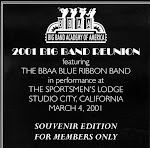This rare audio gem consists of the reticent Bernhart discussing the one occasion on which he performed with Duke Ellington. Duke was hired to write the score for the Frank Sinatra crime thriller, "Assault on a Queen," and a few L.A. studio musicians were brought in to augment the Ellington orchestra. Usually tongue-tied, Bernhart comes out of his shell, describing the thrill of working alongside his Ellington idols and shedding light on Duke's unorthodox method of composing for film.
Gratitude goes to Sheila for helping Milt overcome his fear of speaking into a microphone.
*************
Another reader weighs in on the "Welk Wars" controversy:
Josephine Powell is author of "Tito Puente: When the Drums are Dreaming," published in 2007 by AuthorHouse.
Thanks, Josie. And if still more opinions are percolating out there, we'll be happy to continue facilitating the debate. Send us your thoughts!
"A note about the big bands and dancing.
I grew up in Detroit, where my dad owned a beer garden/dance hall. It had a large dance floor and our customers came to both drink and dance. We were not alone in offering dancing as an attraction, since dancing was held wherever people gathered: ballrooms, churches, picnics, parties and parks.
Movie musicals gave the public more dancing, especially when Fred Astaire broke out with Ginger Rogers in 1933's 'Flying Down to Rio.' Suddenly, dance schools were flourishing. The Arthur Murray chain grew to more than 650 studios, teaching close to 200,000 lessons weekly. Other chains and independent studios did well, too. Schools offered dance contracts predicated on teacher/student dance parties held at upscale hotels and country clubs.
A lawsuit citing the Sherman Anti-Trust Act started the downfall of dance studios. When such dance contracts could no longer be sold, schools closed and ballrooms were shuttered. Without formal instruction, the younger generation didn't learn how to dance and it slowly turned to rock 'n' roll, where no dancing skill is required.
While it's true that WWII policies on recording and the lack of shellac prompted record labels to shift focus onto singers, if not for dancers there never would have been a Stan Kenton, a Woody Herman, a Glenn Miller or a Harry James. All got their starts in dance bands.
My knowledge comes from having lived it: experience as an Arthur Murray teacher, a performer in Las Vegas and as a current member of various dance societies. Concerts without dancing cannot sustain themselves; a couple of gigs a year doesn't do it. But check out Jitterbug conventions. They're the rage. If big bands come back to any degree, it'll be the kids Jitterbugging at these gatherings who make it happen."
Josephine Powell
West Hollywood, Calif.
Thanks, Josie. And if still more opinions are percolating out there, we'll be happy to continue facilitating the debate. Send us your thoughts!






















